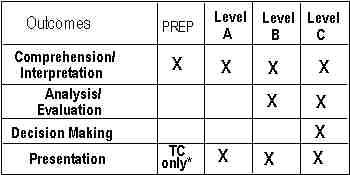
Cooperative Argumentation Instructional
Learning Outcomes
California State University, Monterey Bay offers an interdisciplinary, outcome-based model of general education. The university has developed English-Communication (ENGCOM) Learning Outcomes that integrate oral, visual, and written communication with critical thinking skills. The outcomes included under the rubric of EngCom cover four developmental levels: ENGCOM preparation, Levels “A” (first year lower-division University Learning Requirement), “B” (second year lower-division University Learning Requirement) and “C” (upper-division graduation requirement).
The English- Communication Learning Outcomes, along with their criteria and standards, are described below. The description is followed by a chart which depicts the outcomes and the levels to which they correspond. The Junior Level course syllabus included on this web site corresponds to EngCom C (highest of the four levels), incorporating and aligning with all of the learning elements found on the chart.
ENGLISH-COMMUNICATION
The outcomes indicate the knowledge, skills, and abilities in which students must demonstrate competency. The criteria establish the means by which those outcomes will be assessed (e.g., students are asked to demonstrate comprehension/interpretation in a reasonable and responsive manner). Finally, the standards describe a “satisfactory” level for student performance (the equivalent of passing with a grade of “C”).
OUTCOME: Comprehension/Interpretation: Ability to use empathic and critical
reading, listening, viewing, and speaking skills to understand information and
ideas, to distinguish among diverse genres of communication, to identify a point
of view and its explicit support and to locate significant points of agreement
and disagreement among multiple perspectives.
CRITERIA: Reasonableness and Responsiveness.
STANDARDS:
a. Reasonableness:
• Identify the rhetorical context or genre: audience, purpose, tone, and
perspective
• Summarize and paraphrase key content areas in a particular perspective
• Identify the explicit values, assumptions, emotions, and interests in
a given perspective
• Compare, contrast, and categorize information
b. Responsiveness:
• Describe another perspective with respectful language and connotations
• Recognize bias, commitments, or judgments in own description or inquiry
• Clarify or modify description or inquiry in response to critique
OUTCOME: Analysis/Evaluation: Ability to use empathic and critical thinking skills to understand why different perspectives exist on a given topic and to assess their merits.
CRITERIA: Reasonableness and Responsiveness
STANDARDS:
a. Reasonableness:
• Identify the underlying values, assumptions, emotions, and interests
in a given perspective.
• Determine relevance and significance of explicit and underlying support.
• Recognize inferences and create a synthesis from multiple points of
view in a controversy
• Determine source credibility, coherence, and comprehensiveness
• Identify and account for reasoning fallacies
• Identify all those affected by a controversy or problem
b. Responsiveness:
• Locate and include missing perspectives or information through research
or imagination.
• Acknowledge critique and respectfully engage its reasoning (values,
assumptions, emotions, and interests)
• Recognize bias, commitments, or judgments in one’s own analysis
or evaluation
• Reassess and revise one’s own analysis and evaluation in response
to critique
OUTCOME: Decision Making: Ability to use empathic and critical thinking skills to make ethical and effective decisions.
CRITERIA: Reasonableness and Responsiveness
STANDARDS:
a. Reasonableness:
• Identify a comprehensive range of alternatives
• Identify anticipated consequences for affected or relevant parties
• Assess conflicting rights, needs and degrees of empowerment among multiple
parties
• Decide on an option and provide support for the choice
• Provide a concrete means of accountability for the actual effects of
the decision
b. Responsiveness:
• Explain one’s choice to affected or relevant parties
• Recognize self-interest or preferences in motivation or actual decision
• Clarify or modify in response to critique or unanticipated consequences
OUTCOME: Presentation: Ability to use oral and written communication ethically, effectively, and competently.
CRITERIA: Reasonableness, Responsiveness, and Technical Competency
STANDARDS:
a. Reasonableness:
• Integrates logic and emotion in an internally consistent and coherent
perspective
• Avoids argumentation fallacies
• Supports potentially controversial assumptions and claims
b. Responsiveness:
• Reflects careful consideration of dissenting and divergent means of
support.
• Reevaluates own values, beliefs, assumptions and interests as necessary.
• Shows sensitivity to audience and occasion.
c. Technical Competency:
• Utilizes appropriate English conventions in written and oral communication--in
genre selection, grammar, punctuation, mechanics, and syntax.
• Clarity in purpose and delivery of intended message.
• Creates structural coherence.
• Provides documentation of one’s work where needed.

*TC only refers to the Technical Competency criteria only.